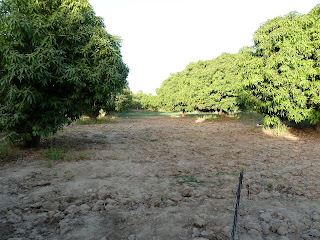In this second installment, we'll give you a brief introduction to what it was like to live in a village with a host family. As part of our training and integration, we spent two months living with a local family under their roof, eating their food, and basically hanging out with them for the times we weren't in school. We'd awake early to get to school by 8:00 am each day, Monday through Saturday, break for lunch at midday, then resume at 2:30 pm to study up until 4:30-5:00 pm each day. As for language, despite Mali being a predominantly French-speaking country (colonially), the dominant language is Bambara, so most of us volunteers have been learning that.
Below are some photos from Cass's homestay situation. This first one is of a large rock, a landmark, that identified the village of Soundougouba Kora.
Here's Cass's family's compound. Most of the buildings within it serve the purpose of sleeping, storing various items that the family owns (including chairs, clothing, furniture), or bathing area. The grounds of the compound serve as essentially dining area, living room, sometimes kitchen, lounge, and meeting or formation areas.
Here's a shot of the village market. Most of the villages tend to have a dedicated area as well as a dedicated day of the week for people to set up shop and sell their wares, be they vegetables, crafts, or other things.
Here's a photo from Cass's sleeping room (his siso).
At school, we were lucky enough to have chalk boards so that we could see the language that we're learning. If you zoom in, you can see what it looks like. If you're wondering about pronunciation, just pretend you're trying to pronounce a French word and you'll probably get it right. For another look at some Bambara, check out this article from Huffington Post about development. The featured image says "Today is Saturday. School is out. Shopeko's father takes his daba (a traditional tool much like a hoe) to go to the field to till it. His mother carries a basket on her head to go to the market. Mariamu went to visit her friend (female)."
Here's our village studying Bambara.
This night photograph of us cooking dinner really captures the ubiquitous dust in the air at all times. From mid-September to May is Mali's dry season. As a result, this lack of humidity means that the air is typically saturated with this fine dust.
Here's a photo of a religious gathering at a local mosque on the Islamic holy day of Tabaski.
The seven volunteers training in Cass's village were all environment volunteers, so they got to get their hands dirty with some gardening. They were also right next to a beautiful mango grove. (We're convinced that it's an empirical fact that mango trees provide the best shade in the universe.)
And a garden! Here's a nursery with lettuce, tomatoes, and cabbage.
Since three quarters of the year is without rain, having a river or canal near by can help greatly with obtaining enough water to irrigate your crops and gardens. This canal was something all of our villagers were proud of, and it was a great landmark that connected us to other homestay villages.
Here's Cathy, who was in a neighboring village. This actually isn't a photograph of Cass's homestay village--it's Carolyn's and was called Baguineda Camp. While Soundougouba Kora was a bruisy agrarian village, B. Camp was more like a small town with shops all over the place.
A banna! (It's over!)














No comments:
Post a Comment